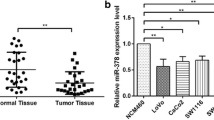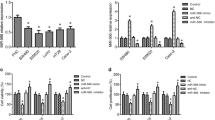Abstract
A previous study demonstrated that miR-126 expression was significantly downregulated in highly metastatic colon cancer cells. This study was to investigate the biological function of miR-126 and its regulation of target genes in colon cancer cells. Quantitative PCR was used to detect miR-126 expression in colon cancer SW480 and SW620 cells. MTT assay was to measure the changed cell viability after miR-126 mimics transfection. Wound healing and Transwell migration and invasion assays measured capacity of tumor cell migration and invasion of SW480 and SW620 cells after miR-126 transfection. Luciferase reporter assay and Western blot were used to assess both transcriptional and expression levels of one of the miR-126 target genes (i.e., CXCR4). Levels of miR-126 expression were lower in colon cancer SW480 and SW620 cells than in the adjacent normal epithelial tissues (P < 0.05). Transfection of miR-126 mimics significantly reduced colon cancer cell viability compared to NC cells (P < 0.05). The wound healing and Transwell migration and invasion assays showed that miR-126 mimics inhibited SW480 and SW620 cell migration and invasion capacity. Bioinformatics predicted that CXCR4 is one of the miR-126 target genes. Indeed, luciferase reporter assay and Western blot confirmed that CXCR4 is a miR-126 target gene. Expression of miR-126 inhibited colon cancer cell viability and reduced tumor cell migration and invasion capacity by its negative regulation of CXCR4 expression.






Similar content being viewed by others
References
Jemal A, Bray F, Center MM, Ferlay J, Ward E, Forman D (2011) Global cancer statistics. CA Cancer J Clin 61(2):69–90
Kudo-Saito C, Shirako H, Takeuchi T, Kawakami Y (2009) Cancer metastasis is accelerated through immunosuppression during Snail-induced EMT of cancer cells. Cancer Cell 15(3):195–206
Pancione M, Forte N, Fucci A, Sabatino L, Febbraro A, Di Blasi A, Daniele B, Parente D, Colantuoni V (2010) Prognostic role of beta-catenin and p53 expression in the metastatic progression of sporadic colorectal cancer. Hum Pathol 41(6):867–876
Roger L, Jullien L, Gire V, Roux P (2010) Gain of oncogenic function of p53 mutants regulates E-cadherin expression uncoupled from cell invasion in colon cancer cells. J Cell Sci 123(Pt 8):1295–1305
Fang YJ, Lu ZH, Wang GQ, Pan ZZ, Zhou ZW, Yun JP, Zhang MF, Wan DS (2009) Elevated expressions of MMP7, TROP2, and survival are associated with survival, disease recurrence, and liver metastasis of colon cancer. Int J Colorectal Dis 24(8):875–884
Wang SC, Lin JK, Wang HS, Yang SH, Li AF, Chang SC (2010) Nuclear expression of CXCR4 is associated with advanced colorectal cancer. Int J Colorectal Dis 25(10):1185–1191
Li XH, Zheng HC, Takahashi H, Masuda S, Yang XH, Takano Y (2009) PTEN expression and mutation in colorectal carcinomas. Oncol Rep 22(4):757–764
Jiang Y, Liu XQ, Rajput A, Geng L, Ongchin M, Zeng Q, Taylor GS, Wang J (2011) Phosphatase PRL-3 is a direct regulatory target of TGF-beta in colon cancer metastasis. Cancer Res 71(1):234–244
Suzuki H, Masuda N, Shimura T, Araki K, Kobayashi T, Tsutsumi S, Asao T, Kuwano H (2008) Nuclear beta-catenin expression at the invasive front and in the vessels predicts liver metastasis in colorectal carcinoma. Anticancer Res 28(3B):1821–1830
Wang Xiaoyan, Wu Minghua, Liu Fen, Li Yu, Li Nan, Li Guiyuan, Shen Shourong (2010) Differential miRNA expression and their target genes between NGX6-positive and negative colon cancer cells. Mol Cell Biochem 345(1–2):283–290
Guo C, Sah JF, Beard L, Willson JK, Markowitz SD, Guda K (2008) The noncoding RNA, miR-126, suppresses the growth of neoplastic cells by targeting phosphatidylinositol 3-kinase signaling and is frequently lost in colon cancers. Genes Chromosom Cancer 47(11):939–946
Li XM, Wang AM, Zhang J, Yi H (2011) Down-regulation of miR-126 expression in colorectal cancer and its clinical significance. Med Oncol 28(4):1054–1057
Tavazoie SF, Alarcón C, Oskarsson T, Padua D, Wang Q, Bos PD, Gerald WL, Massagué J (2008) Endogenous human microRNAs that suppress breast cancer metastasis. Nature 451(7175):147–152
Png KJ, Halberg N, Yoshida M, Tavazoie SF (2011) A microRNA regulon that mediates endothelial recruitment and metastasis by cancer cells. Nature 481(7380):190–194
Crawford M, Brawner E, Batte K, Yu L, Hunter MG, Otterson GA, Nuovo G, Marsh CB, Nana-Sinkam SP (2008) MicroRNA-126 inhibits invasion in non-small cell lung carcinoma cell lines. Biochem Biophys Res Commun 373(4):607–612
Feng RH, Chen XH et al (2010) miR-126 functions as a tumour suppressor in human gastric cancer. Cancer Lett 298(1):50–63
Fish Jason E, Santoro Massimo M et al (2008) miR-126 regulates angiogenic signaling and vascular integrity. Dev Cell 15:272–284
Lagos-Quintana M, Rauhut R, Yalcin A et al (2002) Identification of tissue-specific microRNAs from mouse. Curr Biol 12(9):735–739
Landgraf P, Rusu M, Sheridan R et al (2007) A mammalian microRNA expression atlas based on small RNA library sequencing. Cell 129(7):1401–1414
Majka M, Janowska-Wieczorek A, Ratajczak J et al (2000) Stromal-derived factor 1 and thrombopoietin regulate distinct aspects of human megakaryopoiesis. Blood 96(13):4142–4151
Kijowski J, Baj-Krzyworzeka M, Majka M et al (2001) The SDF-1–CXCR4 axis stimulates VEGF secretion and activates integrins but does not affect proliferation and survival in lymphohematopoietic cells. Stem Cells 19:453–466
Yasuoka H, Tsujimoto M, Yoshidome K et al (2008) Cytoplasmic CXCR4 expression in breast cancer: induction by nitric oxide and correlation with lymph node metastasis and poor prognosis. BMC Cancer 8:340
Burger M, Glodek A, Hartmann T et al (2003) Functional expression of CXCR4 (CD184) on small-cell lung cancer cells mediates migration, integrin activation, and adhesion to stromal cells. Oncogene 22(50):8093–8101
Singh S, Singh UP et al (2004) CXCL12–CXCR4 interactions modulate prostate cancer cell migration, metalloproteinase expression and invasion. Lab Invest 84(12):1666–1676
Wang L, Li CL, Wang L et al (2011) Influence of CXCR4/SDF-1 axis on E-cadherin/β-catenin complex expression in HT29 colon cancer cells. World J Gastroenterol 17(5):625–632
Saur D, Seidler B et al (2005) CXCR4 expression increases liver and lung metastasis in a mouse model of pancreatic cancer. Gastroenterology 129(4):1237–1250
Kollmar O, Rupertus K, Scheuer C et al (2007) Stromal cell-derived factor-1 promotes cell migration and tumor growth of colorectal metastasis. Neoplasia 9(10):862–870
Heckmann D, Laufs S, Maier P, Zucknick M, Giordano FA, Veldwijk MR, Eckstein V, Wenz F, Zeller WJ, Fruehauf S, Allgayer H (2011) Lentiviral CXCR4 overexpression and knockdown model in colorectal cancer cell lines reveals plerixafor-dependent suppression of SDF-1α-induced migration and invasion. Onkologie 34(10):502–508
Acknowledgments
This study was supported in part by grants from the National Natural Science Foundation (No. 81272736), the Natural Science Foundation of Hunan Province (No. 09JJ3066), the Science and Technology of Hunan Province (No. 2009FJ3086), and the Innovative Project of Science and Technology of Hunan Province (No. 2011TT2020).
Author information
Authors and Affiliations
Corresponding author
Rights and permissions
About this article
Cite this article
Li, Z., Li, N., Wu, M. et al. Expression of miR-126 suppresses migration and invasion of colon cancer cells by targeting CXCR4. Mol Cell Biochem 381, 233–242 (2013). https://doi.org/10.1007/s11010-013-1707-6
Received:
Accepted:
Published:
Issue Date:
DOI: https://doi.org/10.1007/s11010-013-1707-6




